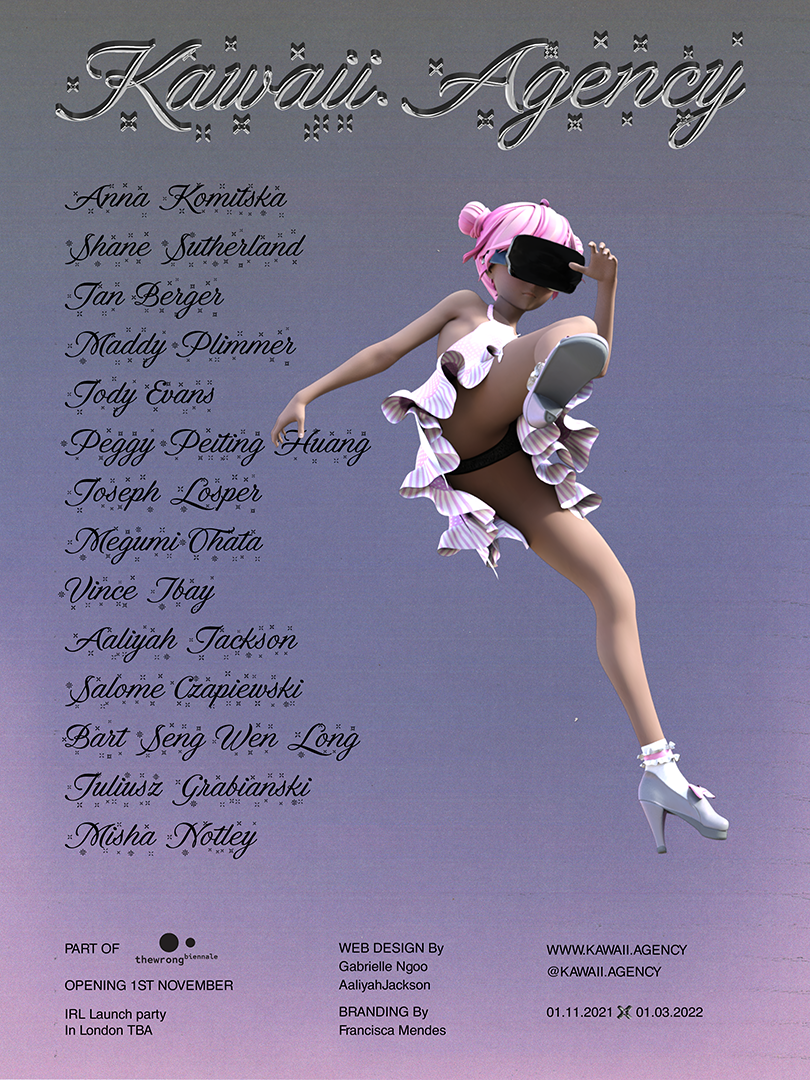Kawaii Agency pavillion at The Wrong Biennale
01.11.2021-01.03.2022



Kawaii Agency is a digital exhibition held as part of the Wrong Biennale. The virtual show centres around the manifold ideas of cuteness found thriving within contemporary culture. It brings together brand new projects by fourteen emerging artists, exploring what cuteness, as an aesthetic or a thematic concern or an existential condition, might mean to them.


















Perhaps that is the evolutionary legacy of cuteness; the sight of young animals triggers dopamine release and helps ensure protection by their caretakers. In fact, some animals deliberately delay or slow down their physiological development to maintain that baseline - case in point, modern humans. In an online economy like that of TikTok or Seeking Arrangement, cuteness becomes a tool in one’s arsenal of self-expression used in a capitalist agenda of appealing for transactional care. And yet, it is surely unfair to paint the cute simply as connivance when it still brims with potential for the sincere. Perhaps all it takes is to wade past the sickly saccharine veneer and truly love it despite being witness to all its potentials of being twisted.
These are all themes that not only inform, but also overlap and converse throughout the artworks produced by Kawaii Agency’s roster of artists. A consistent theme is the diverse contemporary takes on femininity as observed through the cute. We find it in Maddy Plimmer’s Objects and Affair, an interactive dollhouse with its assemblage of adorable furniture - a hands-on exploration of cuteness’ enduring ties with the representation of the feminine and the domestic. This might find kindred connection to Peggy Huang’s Too Cute to be True, a fictional music album whose first track About Dizziness transports the audience into a private musical soulscape where different animated manifestations of herself converge in a meditative seance. Meanwhile, in the respective works of Salome Czapiewski and Jody Evans, the feminine may opt to employ cuteness in more provocative expressions of sexuality. Salome’s visual/text piece Erokawa considers intimately the Japanese lacuna that describes a particularly contemporary eroticism that hinges on cultural perception of cuteness. Jody’s The contents of my bedside table takes an almost typological look at the artist’s own collection of sex toys and the contradiction between aesthetics and intended function. As a timely reminder that sexual cuteness can still demand a heavy price from the women who are seen as walking avatars of adorability, Megumi Ohata’s Kawaii is Justice is a multimedia artwork originating from a traumatic memory, which then finds visceral expression through the joint mediation of cutting edge analogue SFX processes and digital techniques. The line separating cuteness and aggression is also carefully traced in Jan Berger’s The Most Infamous Elf in the History of Cyrodiil, a portrait study of a particular ‘fan favourite’ character from cult video game The Elder Scrolls IV: Oblivion. We later revisit the space between power and vulnerability in Joseph Losper’s videographic poem Akachan, which guides us through a personal memory of cuteness in the artist’s early relationship with his partner. The speed of seduction accelerates in Aaliyah Jackson’s glitchy video installation i_kiss_your_lips which weaves nightcore music and online makeup tutorials together into a hyper-feminine data collage. Using this momentum, we tumble into a psychedelic spiral down the rabbit hole of cuteness’s cultural implications on blackness and femininity in Shane Sutherland’s CUTE, BLACK QUANTUM FUTURE. Leaping through the looking glass, we appear back in modern-day Britain, where Vince Ibay’s project Hugo’s Antiques reflects on class and race relations by reappropriating influencer trends from internet niches such as ToryTok, Asian TikTok and PinoyTok. As we keep scrolling, we can feel the power of cuteness radiating uncomfortably from Bart Seng Wen Long’s video project 44 Minutes, Compressed into a Whole Life, which pits the subversion of masculinity in online catboy culture with the transactional, affective labour of the fetish through an endurance test carried out on a femboy icon. And still glued to the screens of our mobile devices, we watch the deconstruction of algorithmic understanding of cuteness in Anna Komitska’s and Juliusz Grabianski’s projects. In INTRODUCTION 35 ~>tivism, Anna investigates the language of cuteness by training an AI to retell Sienne Ngai’s analysis of the cute. Juliusz, on the other hand, aims to achieve cuteness in its purest form by training an AI to generate statistically cute imagery in his project Synthesising Cuteness. The show is hosted by Misha Notley’s avatar tour guides, taken from her video Love in a Sailor Suit. The anime models appear in a number of 21st century scenarios exploring game aesthetics, world building techniques and a postmodern representation of gender.
We would like to extend a massive thank you to the following people for kindly contributing their personal expertise to the creation of this website:Francisca Mendes for Kawaii Agency’s visual identity and logo design, as well as Aaliyah Jackson and Gabrielle Ngoo for their invaluable work in the overall virtual design of the website. Their labour is truly indispensable, and without it, there is no way we could have staged this show.
Welcome to Kawaii Agency, our laboratory of cuteness. We hope you enjoy this detour in your dopamine-driven journey down the infinite scroll.
︎︎︎

